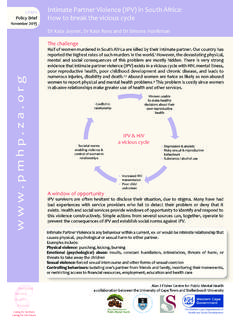Transcription of The Impact of the Opioid Crisis on Children - nisonger.osu.edu
1 The Impact of the Opioid Crisis on Children Guided Notes for Online Learning Name: Date: 1. Table of Contents Section 1: The Opioid Crisis Page 3. Section 2: Addiction Page 4. Section 3: Trauma Informed Care Page 5. Section 4: Impact of Opioids on Children , conception through age 2 Page 7. Section 5: Impact of Opioids on Children , ages 3 through 5 Page 10. Section 6: Developmental Milestones Page 14. 2. 1. The Opioid Crisis The United States is in the midst of an Opioid overdose epidemic. There has been a significant rise in Opioid use and overdoses. There has also been a rise of affected pregnant women and Children . Multiple government agencies have gotten involved, including The Department of Health and Human Services, Centers for Disease Control and Prevention, National Institutes of Health, and the Food and Drug Administration. An Opioid is a man-made chemical that reduces pain in the body. Examples of opioids are _____. The Opioid epidemic impacts Ohio because _____. The Opioid epidemic impacts my students because _____.
2 3. 2. Addiction Opioids work by binding to Opioid receptor sites in the body to reduce pain messages to the brain and decrease the feelings of pain. It also triggers the same processes that give people pleasure. Opioids are highly addictive. Many times, family and friends of those addicted ask questions like. Why can't they just stop, can't they see what this is doing to our family, to our finances? Those suffering from addiction wonder, How did I. not see this coming? This line of thinking, our own personal beliefs and expectations, creates a barrier between us, and those struggling with addiction. My personal beliefs about addiction are _____. Behavior includes are thoughts, emotions, your senses, movement, and memory. All behavior comes from the _____. Opioids change the brain chemistry to help with pain, but opioids can also boost good feelings of pleasure. These affects are only temporary, leading people to take more and more opioids either to decrease the pain or to get those good feelings back.
3 This leads to abuse. Abusing these opioids can actually impair our thinking and affect our behavior, leading to irresistible cravings and later addiction. 4. 3. Trauma Informed Care Adverse Childhood Experiences or ACEs are childhood stresses or traumatic events. ACEs include: emotional/physical neglect, physical/sexual/emotional abuse, intimate partner violence, mother treated violently, household substance abuse, mental illness in household, parental separation or divorce, incarcerated household member. As the number of ACEs increase so does the risk for more adverse experiences, risky behaviors, health problems (both physical and mental), disability, social problems, and death. The Center for Disease Control and Prevention reports as the number of ACEs increase an individual's risk for experiencing one or several of these problems increases: 1. Alcoholism and alcohol abuse 12. Multiple sexual partners 2. Chronic obstructive pulmonary 13. Sexually transmitted diseases disease 14.
4 Smoking 3. Depression 15. Suicide attempts 4. Fetal death 16. Unintended pregnancies 5. Health-related quality of life 17. Early initiation of smoking 6. Illicit drug use 18. Early initiation of sexual activity 7. Ischemic heart disease 19. Adolescent pregnancy 8. Liver disease 20. Risk for sexual violence 9. Poor work performance 21. Poor academic achievement 10. Financial stress 11. Risk for intimate partner violence Traumatic events include: physical abuse/assault, sexual abuse, neglect, verbal abuse, witnessing domestic violence, having an impaired caregiver due to substance use, traumatic grief, experiencing a natural disaster, accidents ( , car), war, and having a life-threatening medical procedure or illness. We must shift our perspective: When we understand that traumatic events Impact all parts of life and development we experience a shift in our thinking. We stop asking what is wrong with you and start asking what happened to you. We understand that if the child can be successful they will choose success.
5 5. One situation where I can shift my perspective in the classroom is _____. Children experience a significant change in the way they see themselves, others, and the world after experiencing a traumatic event. They can experience trauma reminders or triggers. Trauma reminders can be sounds, places, physical touch, smells, feelings, sights, sensations, people, and objects. Trauma impacts body and brain responses. Behavior under stress will fall into one of three possible outcomes. 1. 2. 3. 6. 4. Impact of Opioid Exposure on Children : Conception through Age 2. Drug use during pregnancy is harmful to the developing baby. Many women who abuse opioids experience unplanned pregnancies. The number of babies exposed to opioids during pregnancy continues to rise. Babies who were exposed to drugs during pregnancy are at risk for a condition called Neonatal Abstinence Syndrome (NAS). NAS. is a withdrawal syndrome, meaning the infant is withdrawing from the exposure to drugs in their body before birth.
6 When working with a child who may be experiencing NAS, it is important to consider the signs and how you may respond as a caregiver. Here, we discuss some of the signs commonly seen in babies and toddlers. It is important to note, that most Children may experience one or more of these signs throughout their development and may or may not be related to NAS or other drug-exposure. However, those Children with NAS may show many of these signs and the severity of the symptoms may be more than what you would see in a child without NAS. Infant Signs and Symptoms Toddler Signs and Symptoms 7. Strategies for calming infants: Long Periods of crying or fussing: Jerking of arms and legs: _____. _____. _____. Poor sleeping: _____. Poor Feeding: Spitting up: 8. Diarrhea: _____. Fever or sweating: 9. 5. Impact of Opioid Exposure on Children : Age 3 through 5. Forming relationships can be hard for Children who have been exposed to traumatic events. Challenging behaviors and emotions can arise and can be frustrating to adults caring for the child.
7 The RACE model helps us as adults to meet kids where they are at. RACE. Reflect: 1. Identify the child's challenging behaviors or emotions 2. Identify your blind spots Anticipate: 1. Identify challenging situations Change: 1. Shift your perspective Evaluate: 1. Did it work? Why not? 2. What needs to change? What did you learn One challenging situation where I can use RACE in the classroom is _____. Traumatic Stress' Impact on Development Attachment and Relationships: Thinking and Learning: - Difficulty attaching and separating from - Difficulty with planning, problem- caregivers solving and attention - Distrust of others - Difficulty with learning and language development - Difficulty relating to other people's - Decreased ability to process information perspectives - Decreased curiosity - Difficulty forming and maintaining relationships Physical Health: Behavior: - Increased risk for chronic health conditions - Decreased impulse control - Altered perceptions of pain ( high or low) - Difficulty with rule following - Difficulty with coordination, balance, and body - Increased risk-taking behaviors tone - Increased sleep and eating disturbances - Increased occurrence of developmental delay - May act out traumatic experiences (verbal or physical).
8 Emotional Response: Self-concept: - Frequency of anxiety, depression, etc. - Increased feelings of shame and guilt - Difficulty labeling and expressing feelings - Decreased sense of self - Difficulty communicating wants and needs - Increased disturbances of body image - Difficulty self-regulating - Negative expectations for the future 10. - Decreased self-esteem The possible effects on my students' development include: _____. _____. _____. _____. Emotion and Self-Regulation Young Children must learn about feelings by being taught what feelings are, where they come from, and different strategies to calm down. I am already teaching my students about emotions when I. _____. One thing I would like to add to my lessons is _____. Redirection We have to redirect Children to appropriate activities and behavior many times during the day. Tips for redirection: 1. Utilize humor as a tool for redirection I can use this strategy when _____. 2. Praise students who are performing desired task I can use this strategy when _____.
9 11. 3. Offer opportunities to refocus I can use this strategy when _____. 4. Provide reminders and "do overs". I can use this strategy when _____. 5. Use additional teachers as tools I can use this strategy when _____. I am good at redirection when I. _____. One thing I would like to change about the way I redirect my students is _____. Consistency in the Classroom Children who have a hard time following classroom rules also have a hard time learning classroom expectation if the expectations change often. Rules should not only remain consistent over time but there should be consistency between teachers and across Children . Tips for making constant rules: Keep the classroom rules consistent over time, between teachers, and for each child Keep your personal rules consistent Check in with other teachers regarding rules and the limits that have been set Reinforce the rules others implement My personal rules are 12. _____. _____. _____. My classroom rules are _____. _____. _____. Yes or No -- My classroom schedule is the same daily.
10 I can make it more consistent each day by _____. _____. _____. Environment We can adapt our classroom environments to help our students be successful. We change the classroom by reducing noise and choose a few simple decorations. We can store toys in bins and reduce the amount of toys that are open for play at one time. I plan to change my classroom by _____. _____. Reinforcement Positive reinforcement is a great tool to improve behavior in Children . We all have a paycheck, something we are working for that is motivating us. Identify items or activities that are motivating for Children in your classroom and offer them prior to a challenging situation or when a child does a good job. You can display a list of items or activities each child is motivated for in your classroom for all teachers to see. You can 13. also use a First, Then board for Children who benefit from visuals. For example, first we will finish this puzzle, then you can have bubbles. 6. Developmental Milestones To help you track milestones for Children in your classroom, the CDC (Centers for Disease Control and Prevention), through its Learn the Signs.







